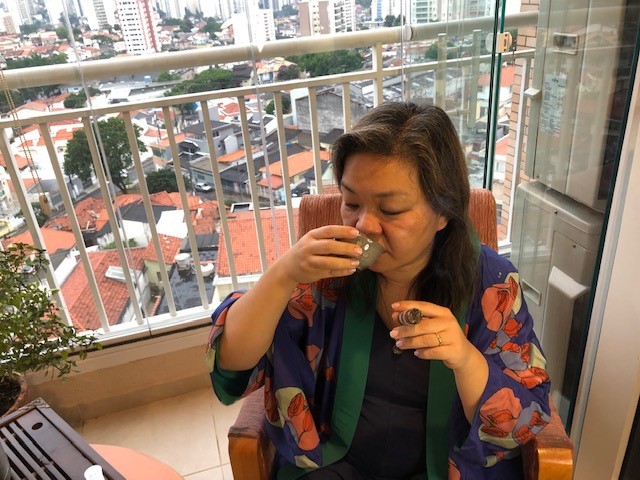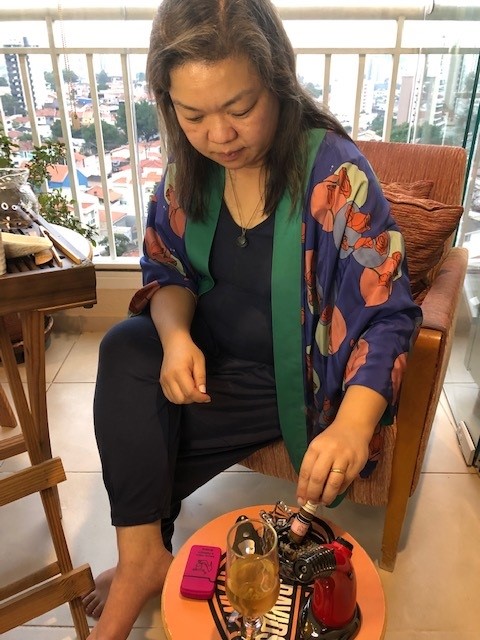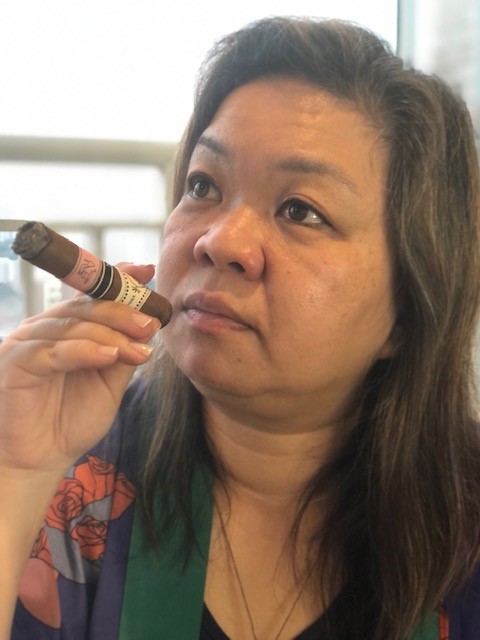The cigars enhance the characteristics of teas thanks to the similarities in the growth process of the two plants
Naturally, people often associate cigars with alcoholic beverages, particularly whiskey or brandy, but rarely with teas. Now, when it comes to experimentation, why not give this duo a chance? After all, there are several similarities in the growth process of tea and tobacco, which allow them to go together very well. As Simone Saito, a specialist in teas and cigars, explains, it is possible to draw a parallel between them: both are leaves that undergo a process of harvesting, processing, drying and, in the specific case of Pu érh tea, fermentation and aging, which provides both with a greater complexity of flavors and aromas and more balance, without loss of body and weight. So, let us put prejudice aside and experiment!

As a person of Japanese ancestry, Saito has been familiar with tea throughout her life, and it is by far the most consumed beverage in her home. As her interest in the subject increased, she decided to deepen her knowledge and became a student of the most experienced Brazilian Tea Master, Carla Saueressig (read the article here). Her interest in cigars came much later, as she shared the passion her husband already enjoyed. Once again, she sought to learn more about this universe and eventually reached the specialist Cesar Adames (www.cersaradames.com), of whom she was also a student. “I have always loved teas and the combination with cigars gives me moments of deep connection with my husband and my fellow cigar lovers. At home, we even have our special corner for our long sessions,” she said.

Tasting
The tasting of teas and cigars can start, according to the specialist, with a simple tea bag, made with chopped leaves and a purito, a small cigar also made with chopped tobacco leaves. “This is a simple experiment that can be very pleasant,” explained Saito. Chopped-leaf cigars are made from 100% tobacco, with no additives. They are usually rolled in machines, just like tea bag leaves, and are picked and rolled by machines, with both having a lower cost.

After this first experience, the professional suggests a tasting on another level, both for teas and cigars. “In the case of premium, more special products, it is possible to pair teas produced with rare leaves and blends meticulously pressed for a certain result. It is possible to taste a specialty tea with specialty cigars, which are processed and aged in drinks, for example. It can be an amazing experience,” she explained.
Pairing
For the pairing between tea and cigars, one must consider, in addition to the flavor, the body of the tea, that is, the weight of the drink in the mouth. That is because the cigar smoked can easily cover the tea’s flavor. Simone Saito explains that the paring of Lapsang Souchoung black tea, for example, is classic and potent, as its combination results in a potentiation of the smokiness of both.

“Jasmine flower-flavored green tea combined with the Arturo Fuente Robusta Candela cigar, which also has the flavor and aroma of jasmine flowers, perfumes the cigar elegantly. Combined with the freshness of green tea it makes a perfect combination. Remembering that the cover of this cigar goes through a process similar to green tea leaves,” she says.

Simone also suggests the combination of teas with Cuban cigars which, in general, have an unparalleled balance of aromas and flavors, regardless of the strength of the tobacco. “I highly recommend a Hoyo de Monterrey Petit Robusto cigar infused with Rooibos, South Africa’s signature tea,” she said.
When choosing a Cuban cigar to pair with, Simone warns that, before the pandemic broke out, 80% of the cigars from that country found in Brazil were counterfeit. “The data are not official, but what I notice is that the supply of Cubans has drastically decreased in all tobacco shops. You have to be very careful where to buy. I would recommend Charutos2Go, Tabacaria Lenat, and Tabacaria Nacional,” she advises.

The U.K.-based online cigar sales (website www.havanahouse.co.uk) has a blog, The Cigar Blog, by Ellie, who recently wrote an article on the rules of pairing tea and cigars, arguing that a darker variety of tea should be paired with a stronger cigar, while a lighter tea goes better with a milder cigar.
In the case of black tea, Ellie explains that the oxidation process that tea leaves go through has a huge impact on the flavor and strength of the tea. “The higher the oxidation level, the richer the flavor and darker the color of the tea. Therefore, black tea will pair particularly well with a rich, aromatic smoke, preventing the flavor of one from being overwhelmed by the other,” she described.
Also according to Ellie, green teas offer complex, herbal flavors in every sip and pair wonderfully with cigars such as Claro or Candela wrapper. Candela teas are green in color due to their processing, which retains the color of the tobacco leaves, which apparently have hints of green tea when smoked.
For white teas, one of the least processed teas, resulting in a very smooth and sweet drink, the specialist suggests a very light and smooth cigar, so as not to overload the tea’s softness.
Cigars – what are they and how are they divided?
A cigar is a smoke composed 100% of tobacco leaves and is divided into three parts: filler (central part), binder (which covers the core), and wrapper (which covers the binder and gives the final finish to the product).
Long Filler – cigars made from whole leaves and rolled by hand;
Short Filler – cigars made with chopped leaves and rolled in machines, cheaper;

Tobacco leaves are divided into three parts: Ligero (consisting of the tobacco leaves located at the top of the plant); Seco (made with the leaves of the central part of the plant); Volado (composed of the bottom leaves, closer to the root of the plant);
Cigars can also be classified and divided according to size (smoking time) and gauge thickness. Another way of classifying cigars is by strength (intensity, potency). They can be mild (1), mild medium (2), medium (3), medium strong (4), and strong (5);
Cigars and their terroirs: Cuban, Off Cuba, Brazilian or National
Cuba has the ideal terroir for the cultivation and production of cigar tobacco. Some of the best brands are Cohiba, Bolivar, H Upmann, Romeo Y Julieta, Monte Cristo, and Partagas.
Off Cuba – are the cigars produced with tobacco seeds from Cuba or other parts of the world, in countries such as Nicaragua, the Dominican Republic and Honduras.
Brazilian or National – these are the cigars produced in the Recôncavo Baiano region, in Brazil. The region has a planting tradition and has attracted renowned factories such as Menendez Amerino, maker of the famous Dona Flor. Dannemann, of Swiss origin, is another manufacturer that produces quality cigars in the region.



